European Research Reactor Conference 2022 – The Report
The European Research Reactor Conference 2022 took place in Budapest, Hungary, from 6 to 10 June 2022.
It has been a successful edition, which had more than 140 participants from all over the world and offered high-quality presentations and content.
The 4-day programme included several Sessions, presenting works and analyses on the different aspects concerning research reactors, like fuel cycle, safety & security, decommissioning and waste management, new projects, utilisation, innovative methods, and operation & maintenance.
For the first time, RRFM hosted also an interesting and engaging Panel Discussion, “Medical Isotopes – Challenges and opportunities for a sustainable supply”, the report of which will be included in the Conference Proceedings.
Finally, a technical visit to the Budapest Research Reactor, gathering more than 60 participants, concluded this year’s edition.
This report has been written by Gawel Madejowski, member of the Polish Nuclear Society – YGN, appointed as Young Generation Reporter for RRFM 2022. Thank you, Gawel, for this detailed contribution!
7th June – The first day of the conference.
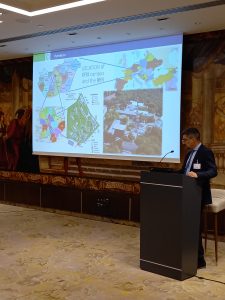
The Head of the Reactor Department of Budapest Research Reactor (BRR), Péter Juhász.
The first day of the conference started with the session devoted to the European and US Research Reactor projects. The speakers gave an overview of the selected contemporary issues in the reactors they represented. The Head of the Reactor Department of Budapest Research Reactor (BRR), Péter Juhász, gave the speech on the facility operation and utilization challenges. He explained the research activities held in BRR as well as its contribution to the network of radioisotopes providers. The speaker described the construction of the cold neutrons source as well as its impressive utilization capabilities.
Afterward, Dr. Sven Van Den Berghe provided a historical perspective on the progress made in the development of a suitable high-density fuel for the conversion of the European High Performance Research Reactors (HPRRs) located in Belgium, France and Germany. He explained the initial setbacks of the U-Mo alloy dispersion fuel and discussed the development of alternative high-density fuel options, such as the high-density silicide fuel for BR2 and the monolithic U-Mo alloy fuel required by the FRM-2 reactor.
After that, Mr. Christopher Landers, representing the Department of Energy National Nuclear Security Administration’s Office of Conversion, gave an overview of collaborative efforts with international and domestic partners on HEU minimization efforts during the last two years of COVID.
Mr. Georgi Simeonov, Policy Officer in the European Commission gave a speech on the security of the supply of radioisotopes in the European Commission’s SAMIRA Action Plan. He reminded that the Plan sets three main priorities: securing the supply of medical radioisotopes, improving radiation quality and safety in medicine, and facilitating innovation and technological development. The speaker emphasized that the SAMIRA activities on the supply of medical radioisotopes have the main objective to create, by 2024, a “European Radioisotope Valley Initiative (ERVI)”.
At the end of the session, Mr. Andre Kolmayer (Nucadvisor) touched on the problem of securing the long-term supply of medical nuclides in Europe. He briefly, yet in very detailed pictured the net of connections between production techniques, targets supply and distribution of key radionuclides. He emphasized the bright future of radiotherapy in the contemporary world.
The Panel Discussion of the day was the Medical Isotopes – Challenges and opportunities for a sustainable supply. The eight experts representing isotopes-producing reactors and radioisotopes-connected companies presented various perspectives on the topic. The key thoughts from the discussion will be published in a separate column.
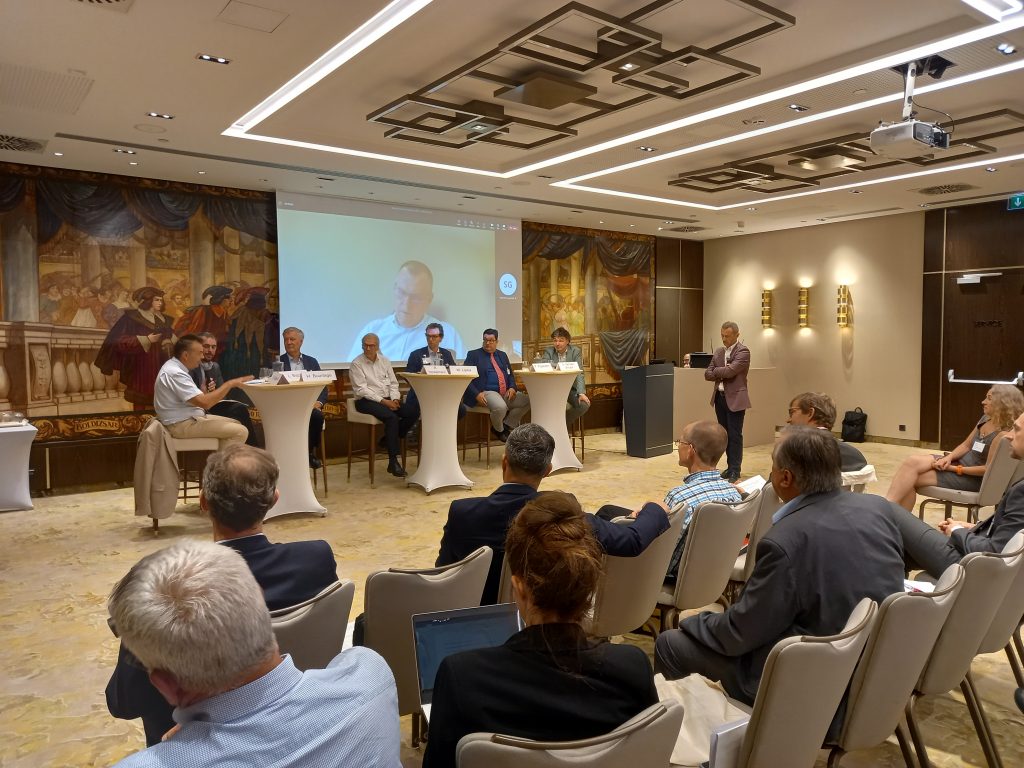
Panel Discussion “Medical Isotopes – Challenges and opportunities for a sustainable supply”. From right to left: Remigiusz Baranczyk (Euratom Supply Agency), Sven Van den Berghe (SCK CEN), Frodo Klaasen (NRG), Maciej Lipka (National Centre for Nuclear Research), Richard Henkelmann (ITM Radiopharma), Harrie Buurlage (SHINE Medical Technologies), Laurent BIGOT (Orano), Gilles Bignan (CEA), and Jean BONNET (Online / IRE – Institute for radioelements).
The third panel’s topic was the new projects. Mr. Anton Shargin (Isotope Jsc) depicted the challenges of ensuring a sustainable supply chain of medical radioisotopes and explained their still growing role in fighting cancer worldwide. Mrs. Alicia Doval from Invap Se considered the dichotomous role of research reactors, being multipurpose research tools and also the irreplaceable isotopic factories. Mr. Laurent Bigot (Orano) gave a speech on the progress in the enriched lanthanides supply project to the research reactor community. Last, but not least, Dr. Gilles Bignan (CEA) described an updated status of JHR experimental capacity under development for the start up of the reactor and the years after.
The final session concerned research reactors utilization. Mr. Marek Migdal, representing MARIA research reactor described the rebuilding of thermostatic irradiation systems capabilities and the lessons learned from the in-core operation tests. He reported achieving the capability of irradiating material samples in the various positions in the MARIA reactor core while keeping them at a temperature up to 1000°C. This allows for conducting effective research on the key problem of fusion and HTR technology – the need for progress in high-end materials. Again, Dr. Gilles Bignan introduced the audience to the topic of CEA re-designation as an ICERR (International Center based on Research Reactor) for the period 2020-2025 in partnership with IRSN. The presentation gave some feedback on the activities performed in the first period of designation (2015-2020) and will detail this new offer indicating how this initiative helps to enhance nuclear capacity building for IAEA Member States. Next, Mr. Bert Rossaert described BR2 reactor irradiation test facilities for research reactor fuel development and qualification. Afterward, Dr. Xiaosong Li demonstrated gamma irradiation capabilities using spent fuel elements at FRM II. Finally, Mr. Alain Moreau gave in insight into the current capabilities of the CABRI experimental reactor.
8th June – The second day of the conference.
The second day of the conference started with the second Session on the utilization of research reactors. It has been started with a speech on the balance between research and production tasks at the IVV-2M research reactor, then Mr. Luis Olivares explained in details the manufacturing process of LEU dispersion type targets for Fission Mo-99 production. Ms. Roberta Cirillo introduced the idea of TOURR, Towards Optimized Use of Research Reactors in Europe, proposing an optimization strategy for European research reactors.
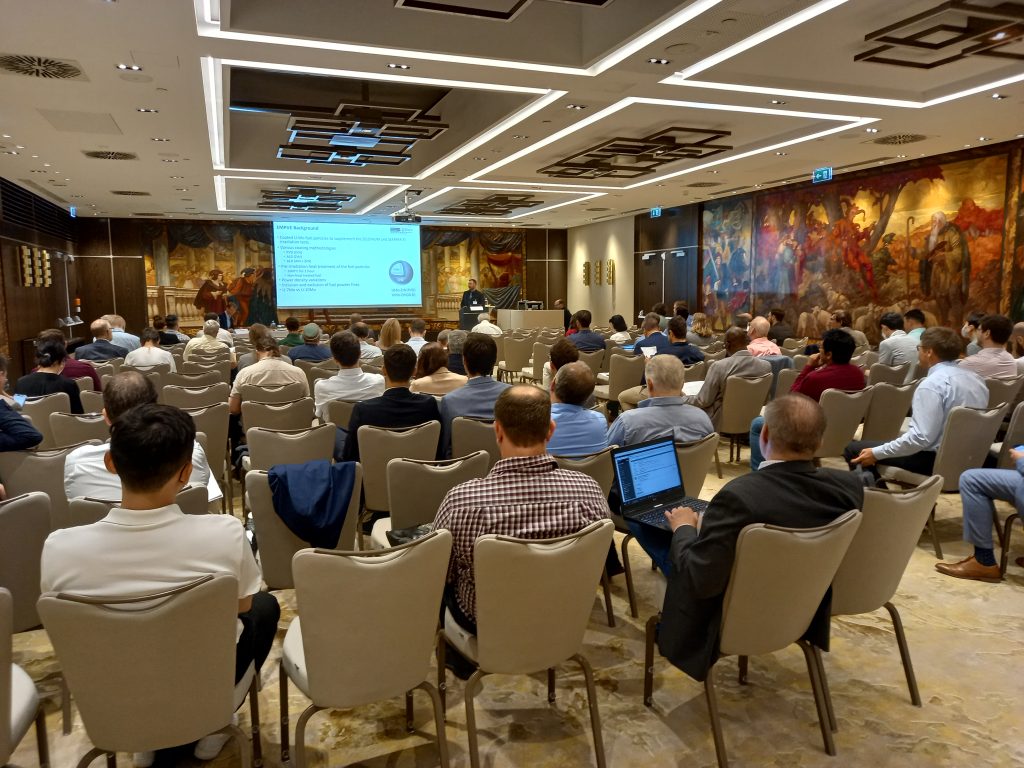
The second, session, devoted to Fuel Cycle, has been dominated by the speakers representing Idaho National Laboratory, reporting the progress in the tests of EMPIrE (European Mini-Plate Irradiation Experiment) fuel. Mr. Adam Robinson and Dr. Laura Jamison showed the results of the non-destructive fuel particle swelling analysis, initial post-irradiation optical microscopy and fuel meat swelling analysis. Finally, Mr. John Dewes reported the development of an approach for down-blending and disposition of irradiated graphite fuel, which is a fuel for IGR pulse reactor.
After lunch, the poster session started. Eleven speakers covered a variety of topics, such as
- the development of a prototype model for a heat transfer studies facility,
- investigation of the deposition constants of non-gaseous fission products on the inner surfaces of the primary circuit,
- ageing management and modernizations at the WWR-SM reactor,
- transient safety analyses for the MUSTANG-R Device in BR2 Using RELAP5,
- image analysis of fuel meat microstructures in plates from EMPIrE,
- high resolution neutron diffraction studies of additively manufactured Inconel 718,
- production of full-size monolithic U-Mo fuel plates,
- simulation of a new WWR-K reactor core aimed at improving the experimental characteristics,
- requirements for nuclear instrumentation systems for a new Korean research reactor,
- safety analyses of the beam shutter for the horizontal beam experimental facility in MARIA research reactor,
- analysis of the rod-drop experiments in JRTR commissioning stage.
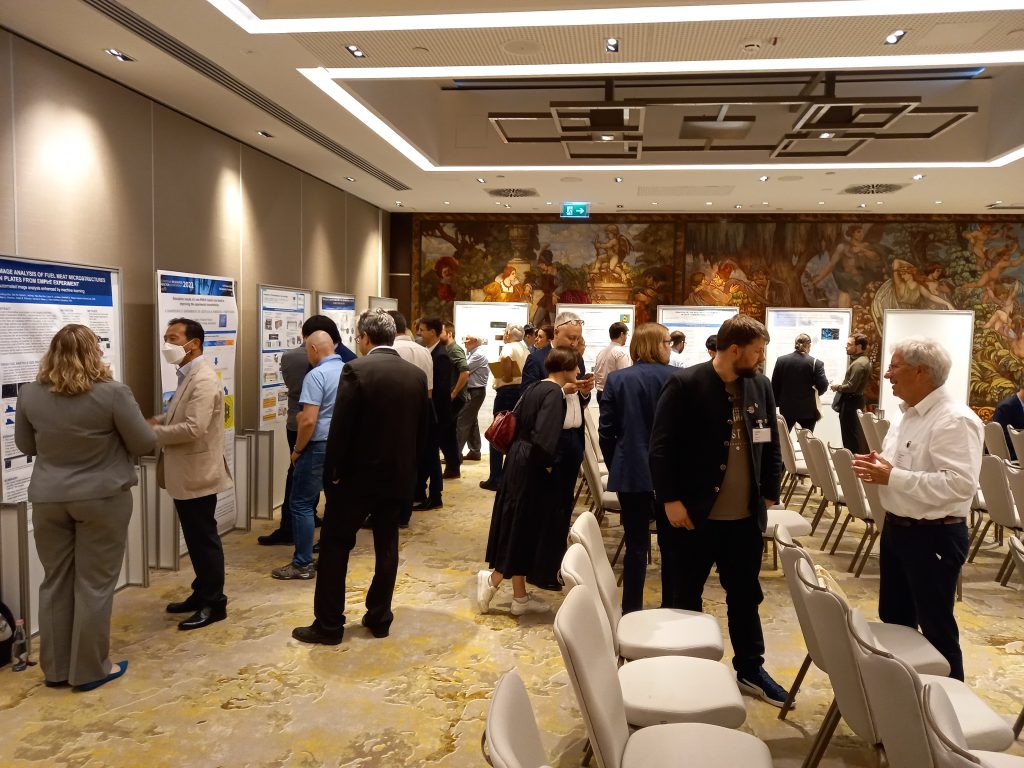
Poster Session
Afterward, the session on safety and security began. Mr. Robin Klein Meulekamp showed current developments on the WENRA reference levels for research reactors, while Mr. Hector Cols described an application of the IAEA safety standards on fire hazards assessment for research reactors. Then Mr. Jerome Estrade communicated the remarks of the ILL’s reactor’s 10-years safety reassessment. In the end, Mr. Arnaud Duthou pushed the idea of the special needs of RRs and SMRs for I&C equipment.
The last, operation and management session was dominated by the ageing management issues. Mr. Jerome Estrade demonstrated an ambitious programme for long-term future operations of the ILL reactor, Mr. Lorenzo Stefanini described the technological obsolescence management program which is strongly based on the IGALL document TOP401 from IAEA . Ms. Ledia Hasa told about the ageing management program of HFR, and Mr. Bartłomiej Piwowarski gave the detailed description of the MARIA reactor ageing management programme, providing some practical examples of the procedures as well as the results of in-service inspection and tests performed.
9th June – The third day of the conference.
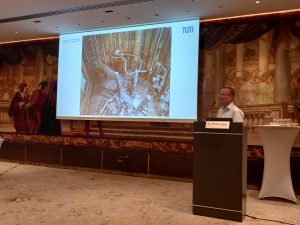
Prof. Axel Pichlmaier – “FRM II: Cold Source Issues, Diagnosis, Removal, Outlook”
During the third day of the conference, several parallel sessions took place. O&M session started with the engaging speeches of Prof. Axel Pichlmaier on the cold neutron source of FRM II and August Winkelman’s on the restarting the Delft research reactor
after an extended shutdown. The challenges of the beryllium poisoning gave however the opportunity to experimentally assess the effect and validate computational techniques. Mr. Darkhan Sairanbayev explained also the dynamics and influence of
beryllium reflector poisoning on the reactivity of the WWR-K reactor core.
At the same time, the speakers of the innovative methods session told about the validation of Serpent 2 using experimental data from the SPERT-IV D-12/25 research reactor tests, high-resolution power density measurement of MTR fuel using gamma spectroscopy, and dispersion fuel mechanical analysis model development for the DART fuel performance code. Furthermore, progress towards conversion scenario for FRM II, Point kinetic parameters calculation for MTR-type fuel assemblies using CONDOR code, and simulation of the CROCUS reactor in the framework of the H2020 CORTEX project have been presented.
Dr. Hironobu Unesaki explained the double heterogeneity effect on the reactivity of U-Mo fuel. The fuel cycle panel speakers have been talking about innovative fuel ideas and two speeches touched on the U-Mo fuel production capabilities. Mr. Maciej Lipka assessed the possibilities of high-performance fuel implementation in MARIA research reactor as well as the analyzed scenario of increasing neutron flux density.
The decommissioning session touched on the problem of irradiated beryllium disposal at the nuclear site. The Safety & Security session has been dominated by advanced modeling issues. The evening panel on the fuel cycle gave a possibility to hear three speeches about impressing performance of the Korean fuel, being developed at KAERI (Jong Man Park, Dr. Sunghwan Kim and Dr. Gwan Yoon Jeong). In the closing session devoted to new projects the overview of JHR history has been told, as well as PSAR PSA for the Pallas reactor. The presenters form KAERI revealed a new concept of hybrid low-power research reactor and the current status of KiJang RR.
10th June – The fourth day of the conference.
The fourth day of the conference was devoted exclusively to the technical visit to the Budapest Research Reactor.
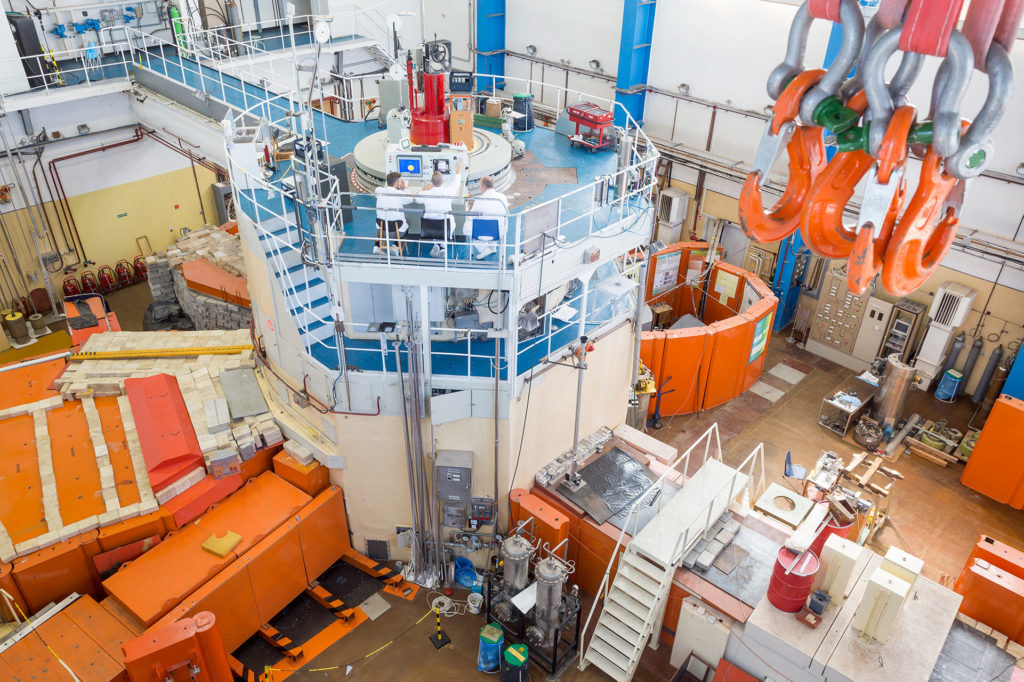 During the extensive tour, the participants visited the ventilation system, the cooling tower, the control room and of course the reactor hall. The participants also visited the hall of physical experiments, where they could see the equipment and the research facilities utilizing the cold neutron source, such as the yellow submarine vessel. The bonus of the visit was the demonstration of the Mobile Expert Support Team of the Nuclear Forensic Laboratory, sometimes known also as fresh food home delivery car as the circumstances demand acting undercover. This mobile set of detectors helps to find orphaned and illegal sources and helps to secure mass events.
During the extensive tour, the participants visited the ventilation system, the cooling tower, the control room and of course the reactor hall. The participants also visited the hall of physical experiments, where they could see the equipment and the research facilities utilizing the cold neutron source, such as the yellow submarine vessel. The bonus of the visit was the demonstration of the Mobile Expert Support Team of the Nuclear Forensic Laboratory, sometimes known also as fresh food home delivery car as the circumstances demand acting undercover. This mobile set of detectors helps to find orphaned and illegal sources and helps to secure mass events.




